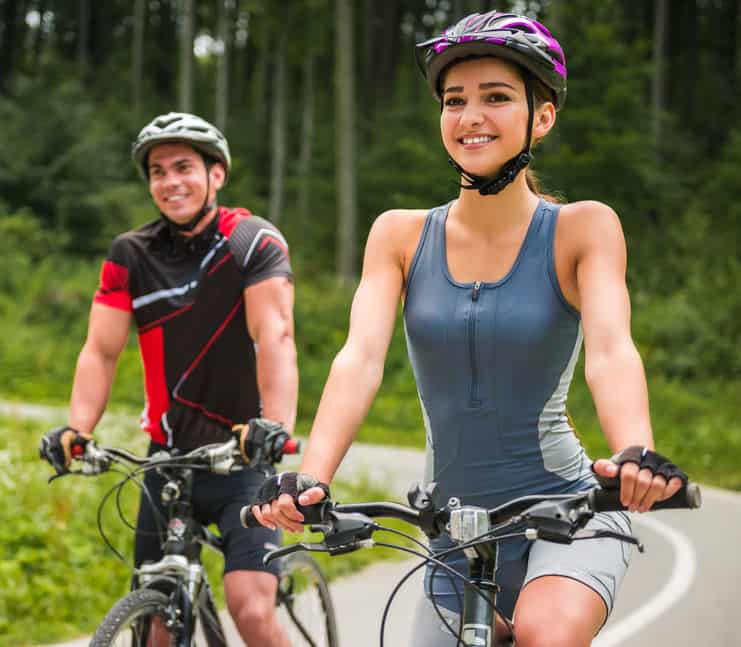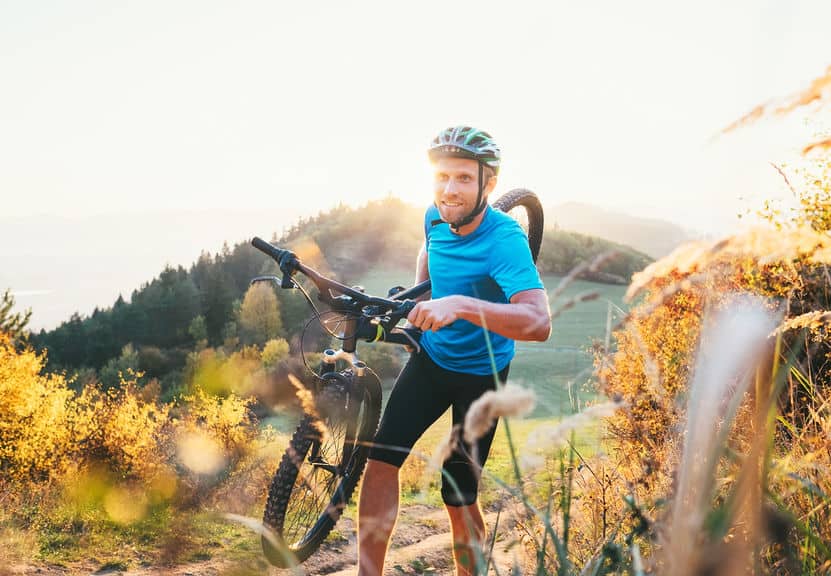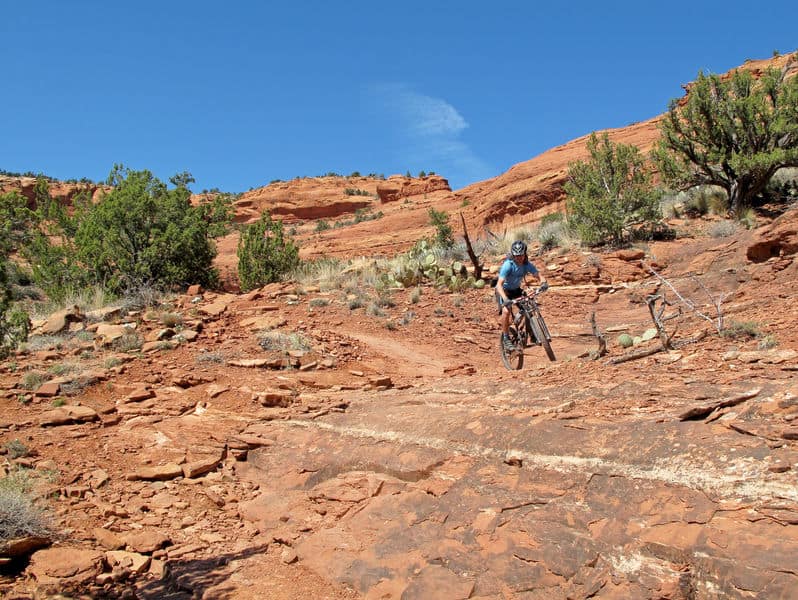With so many different rules, and at least a few different customs that mountain bikers tend to have, it can be really hard to keep track of all of the little details such as who has the right of way and some of the other rules of mountain biking etiquette that you feel that you should remember.
However, if you simply keep these 10 different tips in mind, then you might find that memorizing the trail rules is something that you don’t really have to worry so much about. The biggest tip of all that overarches all of these things is to simply use a bit of common sense when you are out on the trail.
1. Be Aware Of Your Surroundings And Watch Where You Are Going
This one can be compared in a lot of ways to driving a car in that you need to be paying attention to what is around you when you are mountain biking on a trail. Do not get lost in your own thoughts, no matter how amazing the scenery is or get distracted by the sight of wildlife.
Sometimes on crowded trails a faster biker will pass up the slower ones, so just like with driving you also need to pay attention if you hear someone coming up behind you. Since there are no lanes this is especially important to listen for, because you want to let them pass and not be so into the trail that you just so happen to be weaving back and forth and crash into them as they come up.
Going around a corner, especially when you can’t see if someone might be coming from the other way, is also something that you will really have to watch for. Picking that exact moment to turn your head around to say something to another member of your group behind you is just asking for an accident.
In either of these cases if you are not paying attention then there will be no doubt that you are at least mostly to blame for not paying attention. Since no one likes crashing on a mountain bike, it is very understandably a part of etiquette to try to avoid getting into an accident with someone else, both for your sake and for theirs.
2. Take Cues From Those Around You
Perhaps one of the most common rules of etiquette that new mountain bikers want to make sure that they get right is remembering who has the right of way on the trails. This can be a particularly hard set of rules to try to follow since a fair portion of the time the other people on the trail might not know these rules either.
For example, hikers have the right of way so a biker should stop and let them pass, however the majority of hikers are completely unaware that they have the right of way and so they automatically move off of the trail as soon as they see a biker coming. If this happens you do not have to stop and insist that they should go first as this would be just silly, but you should slow down as you pass and give them a thank you.
Another example is that of going downhill, which is even more complicated because some people view it differently. The solution to all of this is quite simple though: watch what the other person is doing and then respond accordingly.
So, if you are going downhill and you see someone coming uphill, then slow down some and watch them. If you see them continue up and seemingly expecting you to stop, then you can assume that they have the right of way – which they actually do – and can pull over and let them by. On the other hand, if you see them pull over to let you by, then you can assume that you have the right of way.
Another thing that you can take your cues from is what the bikers around you are doing. If you see the person in front of you giving the right of way to someone coming from the opposite direction, then it should not be too much to assume that you should do the same.
3. Be Kind To The Trail You Are On
There are a few different parts to this one, but the title pretty much sums it up. It also means that you should be kind to the wildlife that lives around the trail too. You can do this by not leaving any of your trash or anything lying around, but you can also do this by not hurting the trail.
This might sound silly, and may have you wondering how you could hurt a dirt trail. But, think of it this way, how would you feel if you invited someone over to your house and they didn’t like your coat rack and so they got out a nail, hammered it into your wall somewhere, and then hung their coat there? Or, maybe they took their shoes off and wanted to set them at a spot where there happened to be carpet and so they ripped the carpet up in that spot?
While these examples might seem to be just a bit exaggerative, these examples are exactly what you are doing when you widen the trail by riding off of the edge of it or you ride your bike off of the trail entirely and leave a new track in that spot. This might not be the inside of a house, but animals live there and the trails that you ride on were built by someone and are regularly maintained in order to keep them in good condition.
This is way you should try really hard to leave no trace of yourself on the trail and you should treat it as respectfully as you would treat the inside of someone else’s home.
4. Be Kind To Other People
While you are being kind to the trail, you should also use the same reasoning to be kind to the other people who are on the trail and be thoughtful. For example, if you need to stop for a break to catch your breath or because you need to fix a part of your bike, then common sense should tell you that you should not stop in the middle of the trail and be in everyone’s way while you do so!

The same degree of common sense should be used in the parking lot in that you should take into consideration that people will need to have room in order to pack up their mountain bikes, sometimes on roof racks on the top of their vehicles.
Finally, this can also mean not pouring out the last part of your soft drink in a place where someone might step or, worse, on a rock that people might use for sitting on when they are taking a break.
5. Be Polite
While at first glance this might seem to be the same thing as the previous tip on the list, this is actually a different part of it. Being kind to other people is something that you do with your actions which they may or may not ever link to you, whereas being polite is instead something that has to do with the words that are coming out of your mouth and actions that are directly related to other people.
To clarify this: a kind action would be not to pour that soft drink on a popular sitting rock – something no one may ever know you were kind in not doing – whereas a polite action is something that the other person will see and know who is responsible for it.
To give you a good example of this, most people find it very annoying on the freeway when another car is “riding your tail” and this is something that bikers do not appreciate any more than drivers do. This being the case, the polite thing to do if you want to pass someone is to let them know and then give them plenty of space as you wait for them to get to a part of the trail where there is room to let you pass.
The other example of a way that you can be polite is to say things like thank you to people when they do things like giving you the right of way – even if they were supposed to do so. In addition, not cursing someone for being too slow – or in fact for any reason at all – is also a good way to be polite.
6. Take Care Of Your Mountain Bike
While you might view your own mountain bike as something that does not concern anyone but you, you should think again for two main reasons. To show you what one of the reasons is, just picture yourself for a moment riding along and really having a great rhythm going for you. Now gradually introduce a very annoying squeaking noise made by someone else’s bike that is on a completely different rhythm and that reminds you of the idea of fingernails scraping across a chalkboard.
More than likely, this sound would throw you off and you would feel the need to get as far away from whoever was on that bike as possible. Just as you would not want that to happen to you, don’t ride on a squeaky bike yourself if you can help it.
Another thing to consider is just how important mountain bikes are to many of the mountain bikers who ride them. Just as someone who is into cars would be appalled to see a Ferrari mistreated in any way, some mountain bikers feel the same way about mountain bikes.
7. Don’t Brag Unless You Know What You Are Talking About – And Even If You Do
Have you ever been in a conversation with someone who was trying to sound like they were an expert about something all the while you secretly knew that some of the facts that they were sounding were way off? Yeah, that can be pretty annoying sometimes.
What can be worse, however, is if you don’t know that they are off and you base a few actions on the information they give only to find out from experience that they were wrong. However, even when someone is right in what they are saying and you know that they are right, it can still be annoying to have them constantly telling you so.
For these same reasons, you should keep in mind that since you are very likely to find these things annoying, so other people will find you annoying if you do them yourself. A good rule of thumb is that if someone asks you that you can feel free to try to convert them to your way of thinking, but other than that it is usually best to just enjoy mountain biking on the trails.
8. Help Other Mountain Bikers When They Need It
Sometimes accidents happen on the trail, and these can happen to anyone. One rule of etiquette that is really easy to remember is that you should be willing to stop and to lend a helping hand when you see that your help is needed. Sometimes this might be that someone is hurt, but at other times someone can be alright and still need a bit of help when it comes to fixing a part on their bike.

In the latter situation you should be willing to let them use one of your plugs from your plug kit in order to patch the hole in their tire, or even to use your spare tube if you have one and they happen to need it. Who is to say that you won’t be in need of something that you forgot to pack one day?
For this reason most mountain bikers are very firm believers in the fact that you should “pay it forward” and help out someone else who needs your help. Even smaller things like helping someone get their bike onto or off of their roof rack on their car if you see that they are having a hard time with it are things that will be appreciated.
9. Be Prepared
This is another tip that you might not see at first what it has to do with mountain biking etiquette, however I assure you that it can play just as important of a part as the rest of the tips on my list. While sometimes it is impossible to foresee and pack everything that you could possibly need on the trail, you should at least try to pack the basics.
Being prepared can be a very important part of your safety and should not only include a few spare parts for your bike, but also an emergency kit for yourself as well. This is not something that only benefits you, it also benefits the other people around you.
This is something that is even more important if you make a habit of riding with a group of other people or even with just a buddy, since you do not want to become known as the person who is always having to borrow things from other people because you forgot to pack it yourself.
10. Report The Trail Problems
Finally, the last tip on mountain biking etiquette that I have is that you should let other people know if there are any problems with the trail. For example, if you noticed a loose board or something when you went across a wooden feature of the trail, then you should definitely at least let someone know so that they can look into it. This is if you do not go back or stop yourself to examine it and see if it is still safe to go across.
When a bad storm sweeps through the area where a trail happens to be sometimes it can really damage any features, knock over tree limbs or even whole trees onto the trail, and it can also wash out parts of the trail so that you cannot see where the trail is anymore. For these reasons, if you are the first person on a trail after a storm then you should be extra careful and take it easy in case there are any of those things.
However, you should also have the number of the person who is in charge of the trail to let them know about any of those problems so that the affected section of the trail can be closed down temporarily if needed until they can be fixed.
Not reporting when there is a problem can be dangerous for the next person who comes along, especially if they are not as careful as they should be when they are riding down the trail. The sooner that a problem is reported, then the sooner it can be fixed.

